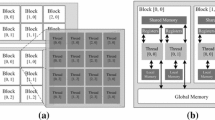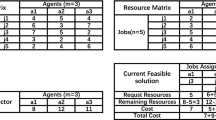Abstract
General Purpose computing over Graphical Processing Units (GPGPUs) is a huge shift of paradigm in parallel computing that promises a dramatic increase in performance. But GPGPUs also bring an unprecedented level of complexity in algorithmic design and software development. In this paper we describe the challenges and design choices involved in parallelizing a hybrid of Genetic Algorithm (GA) and Local Search (LS) to solve MAXimum SATisfiability (MAX-SAT) problem on a state-of-the-art nVidia Tesla GPU using nVidia Compute Unified Device Architecture (CUDA). MAX-SAT is a problem of practical importance and is often solved by employing metaheuristics based search methods like GAs and hybrid of GA with LS. Almost all the parallel GAs (pGAs) designed in the last two decades were designed for either clusters or MPPs. Unfortunately, very little research is done on the implementation of such algorithms over commodity graphics hardware. GAs in their simple form are not suitable for implementation over the Single Instruction Multiple Thread (SIMT) architecture of a GPU, and the same is the case with conventional LS algorithms. In this paper we explore different genetic operators that can be used for an efficient implementation of GAs over nVidia GPUs. We also design and introduce new techniques/operators for an efficient implementation of GAs and LS over such architectures. We use nVidia Tesla C1060 to perform several numerical tests and performance measurements and show that in the best case we obtain a speedup of 25×. We also discuss the effects of different optimization techniques on the overall execution time.











Similar content being viewed by others
Notes
Occupancy is the ratio of active warps to the maximum number of warps supported on a multiprocessor of the GPU, and is helpful in determining how efficient the kernel will be on the GPU.
References
nVidia CUDA Programming Guide 2.1 - CUDA 2.1 SDK Documentation (2008). http://www.nvidia.com/cuda/
E. Alba, B. Dorronsoro, Cellular Genetic Algorithms, Operations Research/Computer Science Interfaces Series, vol. 42 (Springer, 2008)
D. Boughaci, H. Drias, Solving weighted max-sat optimization problems using a taboo scatter search metaheuristic. in SAC ’04: Proceedings of the 2004 ACM Symposium on Applied Computing (ACM, New York, 2004), pp. 35–36
D. Boughaci, H. Drias, B. Benhamou, Solving max-sat problems using a memetic evolutionary meta-heuristic, in Cybernetics and Intelligent Systems, 2004 IEEE Conference on Publication, vol. 1. (2004), pp. 480–484
H. Drias, Scatter search with walk strategy for solving hard max-w-sat problems, in Proceedings of IEA- AIE2001m Lecture Notes in Computer Science, LNAI-2070 (Springer, Budapest, 2001), p. 3544
K. Fok, T. Wong, M. Wong, Evolutionary computing on consumer graphics hardware. IEEE Int. Syst. 22(2), 69–78 (2007)
J. Frank, A study of genetic algorithms to find approximate solutions to hard 3cnf problems, in Golden West International Conference on Artificial Intelligence (Kluwer Academic Publishers, 1994)
H. Hoos, T. Stutzle, Satlib: An Online Resource for Research on Sat (IOS Press, 2000), pp. 283–292. SATLIB is available online at http://www.satlib.org
S. Kirkpatrick, C. Gelatt, M. Vecchi, Optimization by simulated annealing. Science, Number 4598, 13 May 1983 220, 4598, 671–680 (1983)
C. Li, Exploiting yet more the power of unit clause propagation to solve 3-sat problem, in ECAI’96 Workshop on Advances in Propositional Deduction (Budapest, Hungary, 1996), pp. 11–16
C. Li, Anbulagan: Heuristics based on unit propagation for satisfiability problems, in IJCAI (1), (1997), pp. 366–371
J. Li, X. Wang, R. He, Z. Chi, An efficient fine-grained parallel genetic algorithm based on gpu-accelerated, in NPC ’07: Proceedings of the 2007 IFIP International Conference on Network and Parallel Computing Workshops (IEEE Computer Society, Washington, DC, 2007), pp. 855–862
E. Lindholm, J. Nickolls, S. Oberman, J. Montrym, Nvidia tesla: a unified graphics and computing architecture. Micro. IEEE 28(2), 39–55 (2008)
D. Martin, L. George, L. Donald, A machine program for theorem-proving. Commun. ACM 5(7), 394–397 (1962)
M. Matsumoto, T. Nishimura, Mersenne twister: a 623-dimensionally equidistributed uniform pseudo-random number generator. ACM Trans. Model. Comput. Simul. 8(1), 3–30 (1998)
M. Matsumoto, T. Nishimura, Dynamic creation of pseudorandom number generators, in Monte Carlo and Quasi-Monte Carlo Methods 1998 (Springer, 2000), pp. 56–69
B. Mazure, L. Sais, E. Crmoire, A tabu search for sat, in Proceedings of AAAI (1997)
V. Podlozhnyuk, Parallel mersenne twister. CUDA 2.1 SDK Documentation (2007)
B. Selman, H. Kautz, B. Cohen, Noise strategies for improving local search (1994)
J. Stratton, S. Stone, W. Hwu, Mcuda: an efficient implementation of cuda kernels on multi-cores. Technical Report IMPACT-08-01, University of Illinois at Urbana-Champaign (2008)
M. Tomassini, Spatially Structured Evolutionary Algorithms (Springer, Berlin, 2005)
Q. Yu, C. Chen, Z. Pan, Parallel Genetic Algorithms on Programmable Graphics Hardware, vol. 3612 (2005), pp. 1051–1059
Acknowledgments
We would like to thank Dalila Boughachi for her help, regarding the use of genetic algorithms to solve MAX-SAT problem. We would also like to thank the anonymous users who replied to our queries regarding CUDA and GPGPU.
Author information
Authors and Affiliations
Corresponding author
Rights and permissions
About this article
Cite this article
Munawar, A., Wahib, M., Munetomo, M. et al. Hybrid of genetic algorithm and local search to solve MAX-SAT problem using nVidia CUDA framework. Genet Program Evolvable Mach 10, 391–415 (2009). https://doi.org/10.1007/s10710-009-9091-4
Received:
Revised:
Published:
Issue Date:
DOI: https://doi.org/10.1007/s10710-009-9091-4




